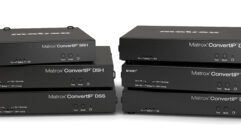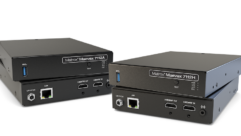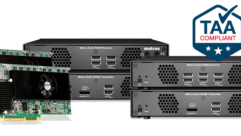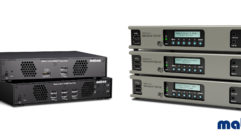
Technology Showcase:
Network Video Appliances
Mar 1, 2006 12:00 PM,
By Jay Ankeney
Autonomous devices send video via IP and local network infrastructures.
Electrosonic MS9400 HD FrEND
In this era of increasing technological complexity, network video appliances are designed for simplicity. Based on technology once referred to as “thin clients,” network video appliances today generally are inexpensive network computers designed to serve as the clients in client/server architectures. Their purpose is to enable business-related video communications and messaging over either a local network or via the Internet through a web server that is accessed by the appliance.
The term “appliance” means these devices are not only self-contained and purpose-built, but that they are also built around an embedded operating system. This makes them secure from outside tampering, including virus infection, and enables the systems to reliably reboot themselves in case of failure. The modern business world has an increasing awareness of outside threats to a corporation’s IT infrastructure, and network video appliances are gaining in popularity because of their low cost, freedom from ongoing maintenance, and inherent reliability. At least one manufacturer reports sales increases of 150 percent over the past year, with demand threatening to outstrip supply.
FROM ROCKETS TO DIGITAL VIDEO
Today’s network video appliances aren’t rocket science — but the idea did begin as rocket science. The first mass-produced embedded computer system was the Autonetics D-17 guidance computer designed for the Minuteman missile in 1961. Then, when the Apollo moon-landing program was conceived later that decade, NASA recognized the need for an absolutely secure inertial guidance computer for both the command module and the lunar module. Charles Stark Draper of the MIT Instrumentation Laboratory came up with the first recognizably modern embedded system, the Apollo Guidance Computer, and each spacecraft was given two of them for redundancy in case one should fail.
By the 1990s, corporate communication departments were facing the complexity of multiple operating systems on multiple platforms running a variety of often incompatible software. This started to escalate the overhead costs in IT departments, but more importantly, it erected barriers to enterprise-wide communications. Then at NAB 1999, Adtec Digital presented the first digital video player with an embedded OS that could serve as a network appliance. Other manufacturers quickly took up the idea. Adtec’s concept lies at the heart of most network video appliances today.
These days digital network technologies dominate facility infrastructures, and network video appliances come in many different configurations for a variety of corporate communication purposes. Some are streaming media systems, others play video in a broadcasting mode, and new, innovative designs combine the best of both approaches. The common link is their embedded operating system, which enables autonomous operations, and their ability to send their information over a network or the Internet to desktop computers. Video is sent to VGA screens or, often, decoded to baseband video for presentation on a conventional standard-definition or HD monitor. The ultimate purpose for network video appliances is to share content from one point to another point.
The category of network video appliances is still maturing, and to nurture its growth the Internet Streaming Media Alliance (ISMA) is working to accelerate the adoption and deployment of open standards for streaming media content — such as video, audio, and associated data — over Internet protocols. On January 17, ISMA released “Internet Streaming Media Alliance Encryption and Authentication, Version 1.1,” also referred to as ISMACryp 1.1. It’s intended as an open-standard specification that provides end-to-end encryption for IPTV and other rich media.
Unlike other protection schemes, content delivered using ISMACryp specs remains encrypted along the entire transmission line and does not need to be deciphered for redistribution or storage. The specification consequently provides important safeguards against unauthorized access to movies, sensitive business video, and other streaming media, and is intended to be a cornerstone in the future development of communication technologies — including in the growing field of network video appliances.
Let’s take a look at the market for this cost-efficient technology that increases the options for corporate communications.

Adtec Soloist 4111 HD
THE MARKET
The Soloist 4111 HD from Adtec Digital embeds both Adtec’s own VTOS (Video Transport Operating System) and a GNU/Linux operating system to provide a true multitasking approach. This lets VTOS take care of the video transport functions while GNU/Linux handles the core I/O. Regardless of source format, the Soloist can automatically scale MPEG-2 content to match the required output target with data rates up to 15Mbps for standard-definition video and up to 25Mbps for 1080i/60 HD playback with multi-channel Dolby Digital AC-3 audio. Adtec Digital’s Soloist HD includes a built-in command interface and scheduler that can play a list of files and loop indefinitely, and it supports H.264 (MPEG-4, Layer 10), Windows Media 9, and MPEG-1 and MPEG-2 video files along with MP3 audio. Thanks to Adtec Digital’s own proprietary line-doubling and reapportionment techniques, SD material can be made to approach near-HD quality levels in both density and proportion.
In addition, Adtec Digital offers the edje-1013, a cost-efficient, hard drive-based digital video player and network appliance. Its built-in On Screen Display (OSD) feature facilitates rendered 24-bit BMP overlays up to full-screen resolution with alpha blending. Edje-1013 supports NTSC and PAL. Durable enough for military applications and designed to integrate into global multimedia networks, the edje-1013 makes dynamic MPEG and bitmap audiovisual presentations without the use of a personal computer possible.

Electrosonic MS9400 HD FrEnd (top unit shows back panel)
New to the Media Networks Division of Electrosonic is the MS9400 HD FrEND (Far End Network Device), a compact, Linux-based appliance that allows high-definition playback. It’s designed to be installed in almost any location that can be accessed over a network. HD FrEND is designed to be economical enough for use in locations where standard-definition video is normally deployed, but this unit allows up to 30Mbps data rates for HD content. Remote management, content distribution, and automation are accomplished over standard IP networks, and Electrosonic offers companion media network software for content management, scheduling, and distribution. HD FrEND supports 1920×1080i and 1280×720p high-definition formats along with 720×576/480p enhanced standard-definition video.
To manage the multiple hardware devices necessary for multi-channel playout, Electrosonic also offers the iMediate suite of media-networking tools that provide secure and efficient video ingest, cataloging, and indexing of video files and scenes, along with multi-channel scheduling and content distribution for education and training.
Mindshare Composer from Envivio is a plug-and-play appliance that records and broadcasts interactive MPEG-4 presentations to desktop and set-top box viewers over IP networks. With both live and non-realtime file production capabilities, Mindshare Composer’s low latency provides an end-to-end delay of less than one second. Mindshare Composer broadcasts the output of any VGA device such as Macs, PCs, electronic whiteboards, document cameras, or medical imaging devices along with the video signal of either a live presenter or a pre-recorded video file. A powerful MPEG-4 Part 11 (also known as Binary Format for Scenes) engine automatically synchronizes video feeds and allows dynamic interaction of the viewer with the content.
In addition, to satisfy the demand for instant access to mission-critical information, Envivio has created an MPEG-4 IP television solution that has been specifically designed for enterprise-level installations. The Envivio InsiteTV system delivers live TV broadcasts and on-demand programming anywhere on a private IP network to be viewed either on a PC, Mac, or television with a set-top box.

Magic Box Aavelin
The VIP is a compact, low-cost unit from Magic Box that features composite, S-Video, and VGA outputs. It’s designed to be useful for everything from community-access cable TV channels to corporate communications — and even digital signage, thanks to its proprietary embedded, multi-threaded operating system that is based on technology licensed from Palm. The VIP can play back Macromedia Flash files, and Magic Box’s VIP Composer software can be used to build pages by placing text over any standard BMP or JPEG image as the background source. These composites can be published to remote units via modem or over a corporate LAN or the Internet.
For even simpler content creation, Magic Box offers Aavelin, a completely scalable network video appliance that can play out messages created on a user’s own Windows PC using any fonts the author chooses. Aavelin can also handle Macromedia Flash files and it supports a variety of aspect ratios including standard 4:3 and widescreen 16:9 in either portrait or landscape orientations. The unit outputs to plasma, VGA, or video screens. The new Aavelin RT has the added ability to overlay Aavelin’s crawl messages on top of live incoming video, and to control Adtec MPEG players for the playback of digital video clips. The Aavelin RT can even convert incoming analog video to VGA for edge-to-edge display on plasma monitors and LCDs.
The latest addition to Optibase’s family of IP streaming gateways, the MGW200 is a compact, single-channel encoding, decoding, and streaming platform designed for corporate IP streaming applications. For full duplex communications, the MGW200 is available with a hardware decoder, which allows simultaneous transmission and reception of video streams. Combined with MGW200’s low-latency feature, this configuration enables instantaneous two-way communications. The MGW200 supports both the Session Announcement Protocol (SAP) and Session Description Protocol (SDP), which lets video channels streamed by the MGW200 automatically trigger the player so the viewer can easily choose between live and scheduled programming. The MGW200’s traffic-shaping mechanism optimizes bit rates and video quality to provide the best video quality over any IP network infrastructure. Its bigger brother is the MGW2000e, which can deliver two live channels of MPEG-1 video at broadcast quality without having to lease two satellite links. It can receive up to six live analog or SDI signals, encode them in realtime to MPEG-1 or MPEG-2, and then stream them over an IP network in multicast or unicast mode.

Optibase MGW200
Pictron’s Video Gateway utilizes searchable video technology to enhance the way video is accessed and used on the Internet and on intranets. Video Gateway automatically detects video scene changes, extracts keyframes, and summarizes the video content into a visual storyboard format. To provide full text-search capabilities, a text transcript of the video is extracted from closed-captioned text or via speech recognition with software called Audio Gateway. Video Gateway can also encode multiple video streams in Real, Microsoft, or MPEG formats during its realtime video indexing, while maintaining absolute synchronization. Pictron’s Video Gateway is tightly integrated with industry-standard SQL servers, text index servers, video servers, and web servers with complete scalability, letting users search and browse video clips over standard Internet browsers or its integrated Video Gateway client software.
Sonic Foundry designed its Mediasite RL440 Rich Media Recorder for corporate presentation facilities such as conference rooms, training rooms, and lecture halls, letting presenters record all audio and visual components of their presentations with the simple press of a button. These components are then presented side-by-side to the viewer while maintaining the synchronous relationship between them. That way the presenter can be seen in a Windows Media file while the PowerPoint presentation from the presenter’s laptop or drawings on an electronic smart board are captured as JPEG files.

Sonic Foundry Mediasite RL440
Built on Sonic Foundry’s realtime Rich Media Engine that automatically captures, encodes, synchronizes, and indexes all audio, video, and visual content, Mediasite uses Sonic Foundry’s patent-pending VersaVisual technology that works with all RGB sources to create high-quality, detailed visual content from PCs, Macs, interactive whiteboards, document cameras, tablets, visualizers, and even testing and diagnostic equipment. Assisted by its embedded Windows XP operating system, Mediasite RL440 integrates seamlessly with existing AV and presentation technologies for fully automated communications by supporting the Mediasite Control Interface Protocol (MCIP) for programmable control with leading AV automation systems through a familiar Crestron or AMX touch panel.
The Symon Digital Appliance (SDA) 500 from Symon Communication is a network appliance in a conveniently small package with a Windows XP operating system embedded so that it can function as an IP/Ethernet network-addressable device. That makes it easy to co-locate with a flat-panel display or standard television screen, putting out its pictures with native support for both widescreen (16:9) and standard (4:3) aspect ratios. Network connectivity enables the SDA-500 to receive content, scheduling, and other instructions from a single Symon Enterprise Server (SES) site. When placed next to a liquid crystal or plasma display unit, the SDA can be connected to the network via a wireless connection (540 and 550 models only) or through standard Cat-5 Ethernet cable. The wireless option enables easy deployment in display areas that are difficult to reach through a wired infrastructure.
Symon also offers TargetVision, an easy-to-implement solution for enterprise-wide sharing of information of all kinds, including employee communications, realtime business data, training, and live external news or video feeds. And to find that information, Symon has Vista, a business dashboard and performance scorecard that delivers a multimedia, multi-vendor, multi-site, enterprise-wide view, all through an IP browser.

VBrick VB6000 WM Appliance
VBrick’s Windows Media video appliances provide scalable video quality at webcasting rates up to 2Mbps. Its WM Appliance is an industrial-strength, versatile system for one-way communications over low- and medium-bandwidth IP networks. WM Appliance uses the widely deployed Windows Media format to let a corporation inexpensively communicate to thousands of people over an enterprise network, VPN, or the Internet. The WM Appliance uses the Windows Media 9 format for video and Windows Media 8 for audio. It supports Windows Media Publishing Points (both push and pull) and includes provisions for metadata insertion and scripting. In an industry first, the WM Appliance can perform both Windows Media encoder services and Windows Media server functionality for live video.
VBrick also offers MPEG-2 network video appliances that provide DVD quality at data rates from 1Mbps to 15Mbps. The MPEG-2 products include an optional hard-drive model called the VBStar as well as the VBSSM, which is a ruggedized model for security and surveillance monitoring applications.
For More Information
Adtec
www.adtecinc.com
Electrosonic
www.mediasonic.com
Envivio
www.envivio.com
ISMA
www.isma.tv
Magic Box
www.magicboxinc.com
Optibase
www.optibase.com
Pictron
www.pictron.com
Sonic Foundry
www.sonicfoundry.com
Symon Communications
www.symon.com
VBrick
www.vbrick.com










